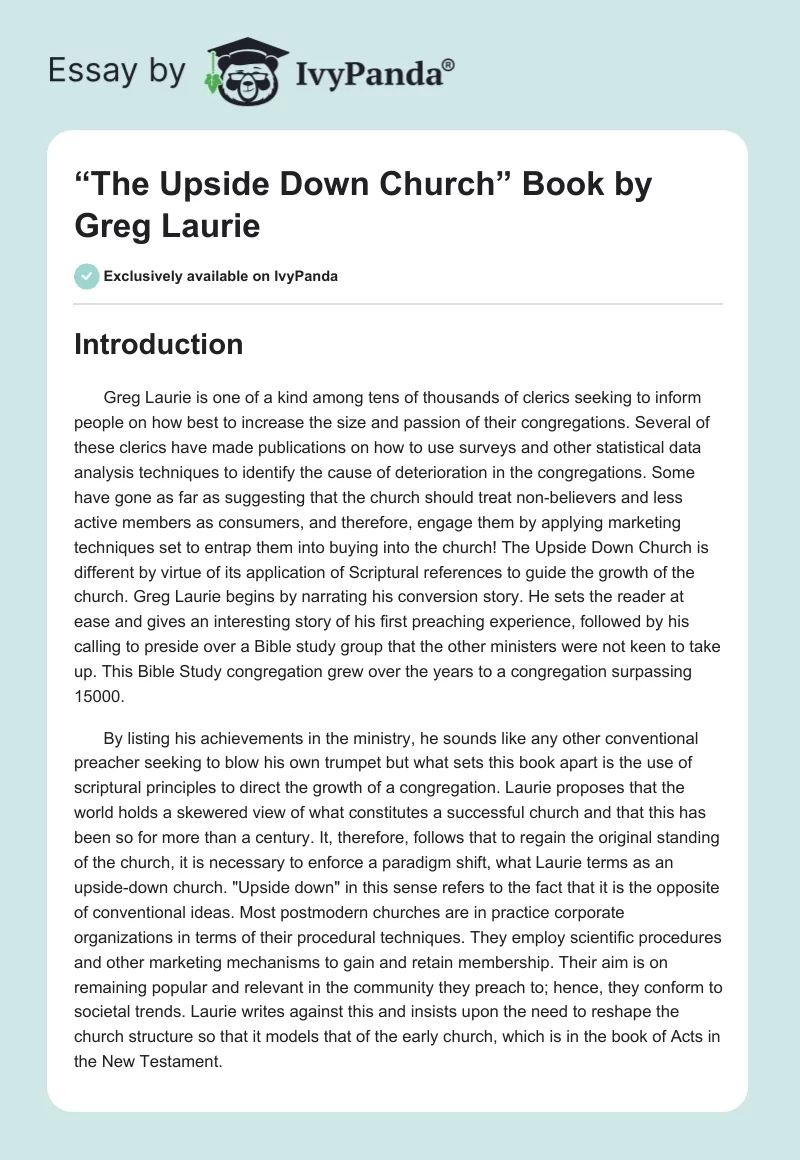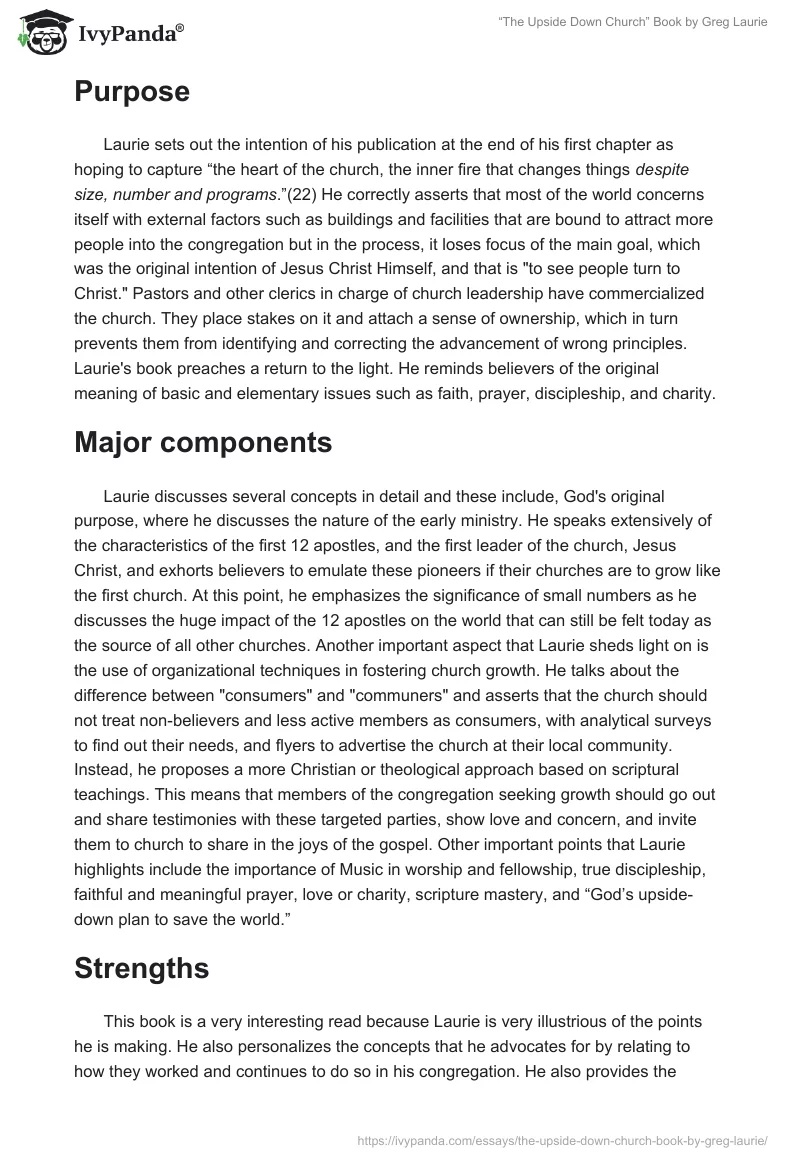Introduction
Greg Laurie is one of a kind among tens of thousands of clerics seeking to inform people on how best to increase the size and passion of their congregations. Several of these clerics have made publications on how to use surveys and other statistical data analysis techniques to identify the cause of deterioration in the congregations. Some have gone as far as suggesting that the church should treat non-believers and less active members as consumers, and therefore, engage them by applying marketing techniques set to entrap them into buying into the church! The Upside Down Church is different by virtue of its application of Scriptural references to guide the growth of the church. Greg Laurie begins by narrating his conversion story. He sets the reader at ease and gives an interesting story of his first preaching experience, followed by his calling to preside over a Bible study group that the other ministers were not keen to take up. This Bible Study congregation grew over the years to a congregation surpassing 15000.
By listing his achievements in the ministry, he sounds like any other conventional preacher seeking to blow his own trumpet but what sets this book apart is the use of scriptural principles to direct the growth of a congregation. Laurie proposes that the world holds a skewered view of what constitutes a successful church and that this has been so for more than a century. It, therefore, follows that to regain the original standing of the church, it is necessary to enforce a paradigm shift, what Laurie terms as an upside-down church. “Upside down” in this sense refers to the fact that it is the opposite of conventional ideas. Most postmodern churches are in practice corporate organizations in terms of their procedural techniques. They employ scientific procedures and other marketing mechanisms to gain and retain membership. Their aim is on remaining popular and relevant in the community they preach to; hence, they conform to societal trends. Laurie writes against this and insists upon the need to reshape the church structure so that it models that of the early church, which is in the book of Acts in the New Testament.
Purpose
Laurie sets out the intention of his publication at the end of his first chapter as hoping to capture “the heart of the church, the inner fire that changes things despite size, number and programs.”(22) He correctly asserts that most of the world concerns itself with external factors such as buildings and facilities that are bound to attract more people into the congregation but in the process, it loses focus of the main goal, which was the original intention of Jesus Christ Himself, and that is “to see people turn to Christ.” Pastors and other clerics in charge of church leadership have commercialized the church. They place stakes on it and attach a sense of ownership, which in turn prevents them from identifying and correcting the advancement of wrong principles. Laurie’s book preaches a return to the light. He reminds believers of the original meaning of basic and elementary issues such as faith, prayer, discipleship, and charity.
Major components
Laurie discusses several concepts in detail and these include, God’s original purpose, where he discusses the nature of the early ministry. He speaks extensively of the characteristics of the first 12 apostles, and the first leader of the church, Jesus Christ, and exhorts believers to emulate these pioneers if their churches are to grow like the first church. At this point, he emphasizes the significance of small numbers as he discusses the huge impact of the 12 apostles on the world that can still be felt today as the source of all other churches. Another important aspect that Laurie sheds light on is the use of organizational techniques in fostering church growth. He talks about the difference between “consumers” and “communers” and asserts that the church should not treat non-believers and less active members as consumers, with analytical surveys to find out their needs, and flyers to advertise the church at their local community. Instead, he proposes a more Christian or theological approach based on scriptural teachings. This means that members of the congregation seeking growth should go out and share testimonies with these targeted parties, show love and concern, and invite them to church to share in the joys of the gospel. Other important points that Laurie highlights include the importance of Music in worship and fellowship, true discipleship, faithful and meaningful prayer, love or charity, scripture mastery, and “God’s upside-down plan to save the world.”
Strengths
This book is a very interesting read because Laurie is very illustrious of the points he is making. He also personalizes the concepts that he advocates for by relating to how they worked and continues to do so in his congregation. He also provides the reader with a different approach to church growth. It is different from other notions of what constitutes an effective plan to grow one’s congregation and this is evident in other publications such as “The purpose Driven Church.” Such other publications advocate for worldly means of effecting growth such as surveys and interviews coupled with advertisements and flashy buildings and facilities. In contrast, Laurie proposes a very simple and basic plan. One that is affordable and accessible to all who own a bible as he extracts it from the book of Acts, in the New Testament. This prevents him from sounding like a cliché in his writings. He gets all his principles from the scriptures and he always prefers theology to societal values.
Weaknesses
This 219-page read is too general. Laurie speaks of general principles, which he fails to conceptualize or relate to direct situations. He does not break these down so that a reader can know how exactly to apply them in his / her specific content. The result of this is that after reading this book, a reader feels that he/she can cause change to happen but he/she does not know where to start. Laurie makes poignant observations and suggestions but he leaves it at the discretion of the reader to translate these into action, which is a risky situation because misinterpretation becomes an option. Secondly, at the beginning of the book, he puts off the reader by starting in a “bragging” tone. He lists his accomplishments and then goes ahead to number his congregation. This is capable of putting a reader before they begin to read the main message which is actually worth reading.
Applicability to Churches
Although too general, the principles that Laurie presents are very applicable to all churches. All denominations can use these principles to effect growth in both size and morale of their congregations. In fact, the general nature of these suggestions becomes a positive factor because that way, the reader can customize the concept to best suit their situation. One needs only to grasp the general idea, and then go about shaping it to suit his / her purposes. The chapter on boosting a congregation’s morale is especially helpful, and the general point about the church needing to undergo a paradigm shift actually applies to all churches. Laurie asks some interesting questions that force a person to reflect upon self-worthiness. He demonstrates just to what extent the contemporary world dilutes the original gospel and its purpose and reminds readers that for as long as they fall short of the standards set originally by God, they have no right to expect salvation.
Implications and Recommendations
This book is a good herald for change. It makes a reader realize the need to change the traditional or conventional way of doing things. Moreover, it provides the better alternative that it is proposing that the world adopts and Harvest Christian Fellowship is a living example of the success one can expect if they base their procedures and teachings strictly on scripture. However, in case of a revision of this edition, it would help if the author indicated more specifically what it is exactly that congregations and their leaders need to do and how to go about this monumental change. More instructions on this process would enable readers to have a better understanding and more importantly, to be in a position for a better application of the principles indicated in this volume. Finally, the first chapter can do with some revision as well, if not of anything else, the tone of the author. This is because in its present form it comes out as pride on the part of the author, which may put a reader off before they partake of the truly enriching message within the rest of the book.
Conclusion
The “Upside Down Church” is a very educative volume that I would recommend to all Christian believers seeking to grow their faith and congregations. It is different from other publications, whose writers intend that they serve the same purpose as this because it bases its arguments on pure scripture. Except for the few revisions suggested in this paper, it is perfect.


